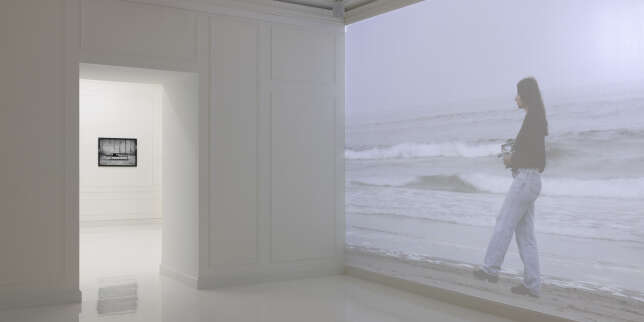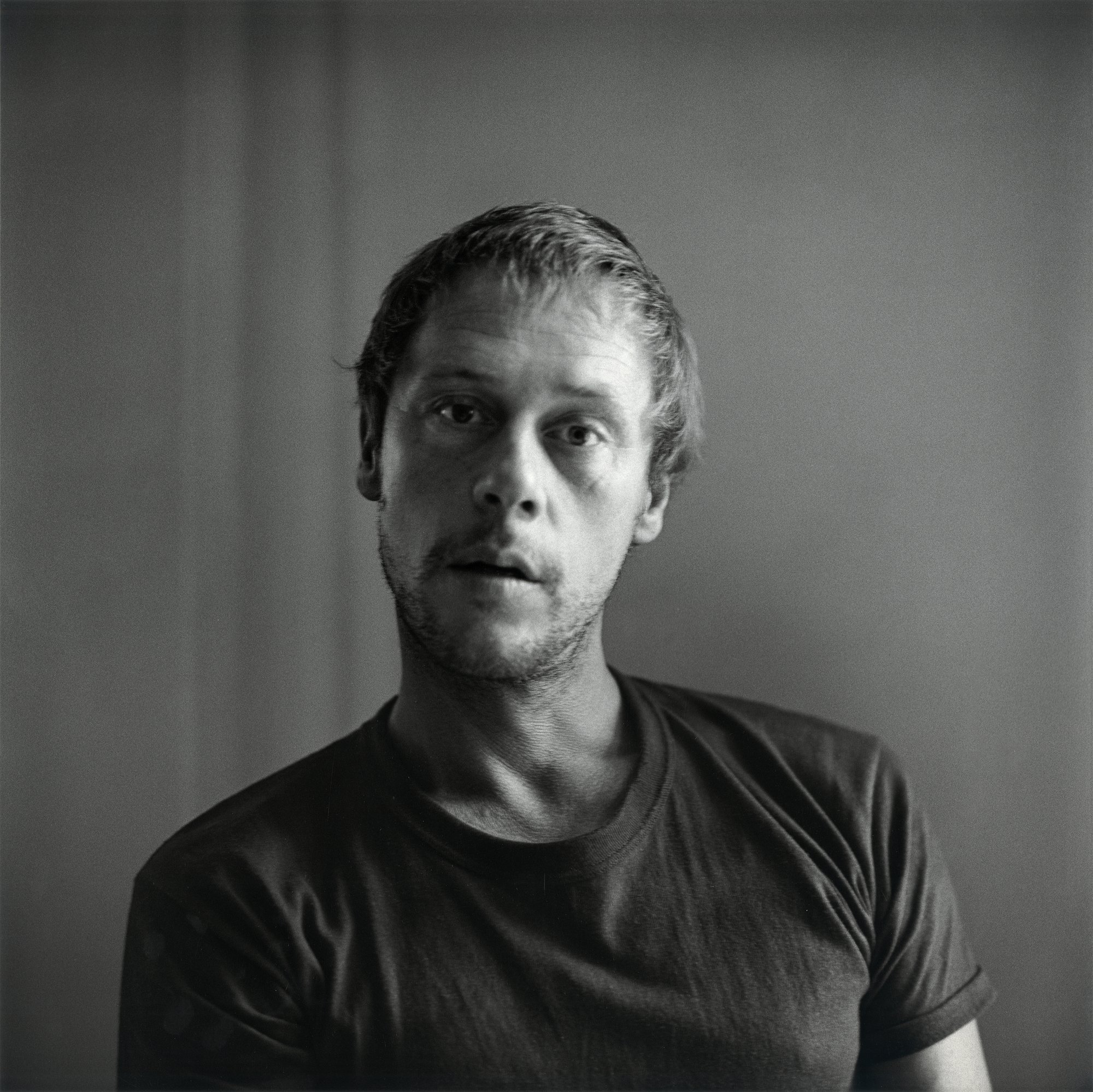Vertical 14 (Ajarani, RR)
1984 - Photography (Photography)
57 x 38.5 cm
Claudia Andujar
In 1980, with the construction of highways in Indigenous territories, an epidemic was brought to the Yanomami region. As the Yanomami do not have first names, it was necessary to give them numbers to indicate that they had already been vaccinated and identify each one for their medical records. From this series of events, Claudia Andujar’s Marcados series was born: what was supposed to be a mere photographic record, for organizational purposes, ended up raising a big question about the “labels” given to people in the construction of societies. The series includes 82 photos of the expedition and was initially published together with texts and reports by the artist in the Commission for the Creation of the Yanomami Park. Vertical 14 (Ajarani, RR) from the Marcados series gives a glimpse into the intimacy, trust, and understanding Andujar has built with the Yanomami, one of Brazil’s largest Indigenous groups. According to the artist, this is related to her personal history. Born in Europe, the artist lived through World War II. Her entire family was killed in a concentration camp by the Nazi regime, where people were marked to die. Andujar’s portraits with numbers became a tool for the survival of the Yanomami people and culture. For the photographer, “They are marked to live, not to die.” These portraits, taken in the 1980s are as relevant as ever in a post-pandemic world. The raising of new sanitary borders render social injustices in Brazil even more visible. The Brazilian demarcated territory, for which Andujar fought all her life, is now suffering once more with an increase in malaria, Covid-19, and chronic child malnutrition, in addition the Indigenous populations are facing a significant invasion of miners, encouraged by those in power and extractivist corporations operating in the rainforest.
Claudia Andujar was born in Switzerland in 1931, and then moved to Oradea, on the border between Romania and Hungary, where her paternal family, of Jewish origin, lived. With the persecution of Jews during World War II, she fled with her mother to Switzerland and then emigrated to the United States. In 1955, she came to Brazil. Having spent most of her life in a permanently foreign condition, Claudia turned photography into a working tool and a means of contact with the country. Over the following decades, she travelled all over Brazil and collaborated with national and international magazines such as Life, Aperture, and Look, among many others. For almost seven decades, Andujar has been thoroughly involved with the Yanomami community in the Amazon; grappling with the challenges of visually interpreting their daily lives in sharp black and white imagery, as well as attempting to visually translate their shamanic culture through more experimental techniques like flash devices, oil lamps, and infrared film. Her works deliberately stands in the threshold of visual collage, documentary, and activism, perceiving photography as a tool for political change and raising awareness to the complexity of the daily life and traditions of her subjects, their restless resistance and dignity, and the ongoing injustices they have been subjected to for centuries. Andujar’s images of life in the rainforest and her political involvement with Indigenous causes made her an internationally recognized leading voice in defense of the Indigenous people of Brazil, whose land has been in constant threat by development and illegal mining activities, and more recently by a far-right government that have been actively revoking the rights of Brazilian native populations.
Colors:
Related works sharing similar palette

© » LE MONDE
Sarah Brahim remonte ses souvenirs dans un maelström de gestes et de sons Cet article vous est offert Pour lire gratuitement cet article réservé aux abonnés, connectez-vous Se connecter Vous n'êtes pas inscrit sur Le Monde ? Inscrivez-vous gratuitement Article réservé aux abonnés Vue d’ensemble de « Sometimes We Are Eternal », exposition de Sarah Brahim, à Lugano (Suisse), en octobre 2023...

© » ANOTHER
The Story Behind Iconic 90s Images of Cameron Diaz, Heath Ledger and More | AnOther As his new exhibition opens in Milan, Michel Haddi tells us the story behind some of his most famous images of Gwyneth Paltrow, Kate Moss, Janet Jackson and more December 11, 2023 Text Gary Grimes Michel Haddi , the legendary French-Algerian fashion photographer, is a big believer in the importance of first impressions...

© » KADIST
Camel Collective
2018Gated Commune , a video by Camel Collective, is a critique of the complex, and often obtuse, language used to describe sustainable development projects...

© » ARTS EQUATOR
Weekly Picks: Malaysia (24–30 Dec 2018) | ArtsEquator Thinking and Talking about Arts and Culture in Southeast Asia Weekly To Do December 24, 2018 Tales of Apocalypse Exhibition by Latif Maulan , at Galeri Titikmerah, 22–31 Dec An exhibition of recent artworks by contemporary self-taught artist Latif Maulan, in the artist-run space Galeri Titikmerah in Publika...

© » KADIST
Haegue Yang
2010In addition to Yang’s signature drying rack and light bulbs, Office Voodoo includes various office supplies like CDs, paper clips, headphones, a computer mouse, a stamp, a hole puncher, a mobile phone charger...

© » SLASH PARIS
Gildas Le Reste — & Guests — Galerie Catherine Putman — Exposition — Slash Paris Connexion Newsletter Twitter Facebook Gildas Le Reste — & Guests — Galerie Catherine Putman — Exposition — Slash Paris Français English Accueil Événements Artistes Lieux Magazine Vidéos Retour Précédent Suivant Gildas Le Reste — & Guests Exposition Dessin, estampe, peinture Gildas Le Reste, Notes de voyage #1, 2023 Encre sur papier marouflé sur toile Gildas Le Reste & Guests Encore 27 jours : 27 janvier → 9 mars 2024 La galerie Catherine Putman est heureuse de proposer une double invitation à Gildas Le Reste, comme artiste et commissaire d’exposition...

© » KADIST
Andrew Norman Wilson
2019In Andrew Norman Wilson’s work Kodak the artist uses computer-generated imagery to create narratives that question the reliability of images in the age of post-production...

© » KADIST
Zarouhie Abdalian, Rocky Cajigan, Jesse Chun, Nikita Gale, Shilpa Gupta, Baseera Khan, Tarik Kiswanson, Alexis Smith, and Cecilia Vicuña Be here, or even better, be nowhere brings together artists who employ sculpture, drawing, video, and sound to probe social and historical structures and infrastructures, such as migration, colonialism, carceral systems, and space militarization...

© » KADIST
Huang Xiaopeng
2011Four knives appearing as if thrown at the wall to alleviate frustration and boredom, form rhythmic shadows and markings of time above a translated phrase boldly printed in simplified Chinese and English...

© » KADIST
Société Anonyme: Week 5 March 3 – 16, 2008 Saturday, March 8, from 6 – 9 p.m Presentation of “Art conceptuel, une entologie” (Editions MIX, edited by Gauthier Herrmann, Fabrice Reymond & Fabien Vallos) “Art Conceptuel, une entologie” is a collective translation experience of 278 conceptual artworks, most of them available for the first time in French...










